
The Sphingidae are a family of moths commonly called sphinx moths, also colloquially known as hawk moths, with many of their caterpillars known as "hornworms"; it includes about 1,450 species. It is best represented in the tropics, but species are found in every region. They are moderate to large in size and are distinguished among moths for their agile and sustained flying ability, similar enough to that of hummingbirds as to be reliably mistaken for them. Their narrow wings and streamlined abdomens are adaptations for rapid flight. The family was named by French zoologist Pierre André Latreille in 1802.

The Tennessee warbler is a New World warbler that breeds in eastern North America and winters in southern Central America, the Caribbean, and northern South America. The specific name peregrina is from Latin peregrinus "wanderer".

The peony or paeony is a flowering plant in the genus Paeonia, the only genus in the family Paeoniaceae. Peonies are native to Asia, Europe, and Western North America. Scientists differ on the number of species that can be distinguished, ranging from 25 to 40, although the current consensus describes 33 known species. The relationships between the species need to be further clarified.
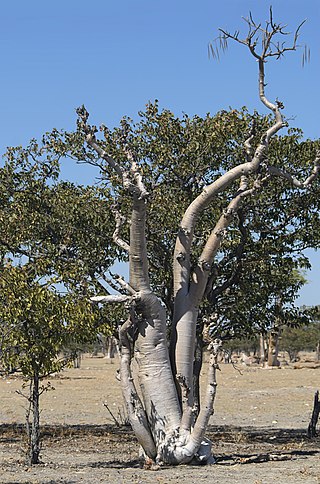
Moringa is the sole genus in the plant family Moringaceae. It contains 13 species, which occur in tropical and subtropical regions of Africa and Asia and that range in size from tiny herbs to massive trees. Moringa species grow quickly in many types of environments.

Comptonia peregrina is a species of flowering plant in the family Myricaceae native to eastern North America. It is the only extant (living) species in the genus Comptonia, although a number of extinct species are placed in the genus.
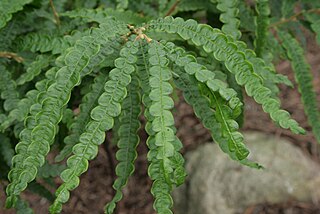
Comptonia is a genus of flowering plants in the family Myricaceae, native to parts of eastern North America. It has one extant (living) species, Comptonia peregrina, and a number of extinct species.

Colpomenia peregrina, sometimes referred to by its vernacular names oyster thief and bladder weed, is a species of brown seaweed.

Cataclysta lemnata, the small china-mark, is a moth species of the family Crambidae. It is found in Europe, Morocco and Iran.

Parapoynx stratiotata, the ringed china-mark, is a moth of the family Crambidae. The species was first described by Carl Linnaeus in his 1758 10th edition of Systema Naturae. It is found in Europe where the distribution area extends in the north to the British Isles including Ireland and in the south to Sardinia, Sicily and Greece. The species is also found across the Palearctic in North Africa, Lebanon, Turkey, Azerbaijan, Kyrgyzstan, Uzbekistan and China..

Coleophora serratella is a moth of the family Coleophoridae. It is found in Europe, Japan (Hokkaido) and North America.

Eoophyla is a genus of moths of the family Crambidae. It was erected by Charles Swinhoe in 1900.
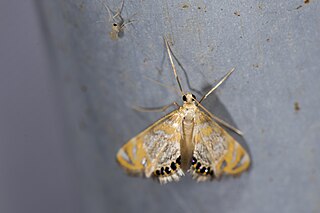
Nymphicula is a genus of moths of the family Crambidae.

Prays fraxinella, also known as the ash bud moth, is a moth of the family Plutellidae found in Europe. The larvae are leaf miners, feeding on the leaves and buds of ash trees.
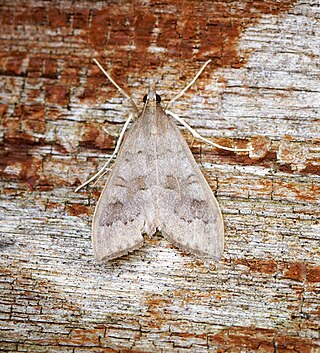
Mecyna asinalis, sometimes known as the madder pearl, is a species of moth of the family Crambidae found in Europe.

Prays is a genus of moths of the family Praydidae, formerly assigned to Plutellidae or Yponomeutidae.

Parapoynx fluctuosalis or Fluctuating China-mark or Waved China-mark, is a moth of the family Crambidae. It is a widespread species, known from Africa, India, Sri Lanka, China, Japan, Malaysia, Taiwan, Guam, Hawaii, Fiji, Australia and the Galápagos Islands. It is also an introduced species in Europe, where it has been recorded from Great Britain, the Iberian Peninsula and Sardinia.

Cyana peregrina is a moth of the family Erebidae. It is found in India and Sri Lanka. The habitat consists of forests.

Rubia peregrina, the common wild madder, is a herbaceous perennial plant species belonging to the bedstraw and coffee family Rubiaceae.
Choristoneura zapulata, the zapulata moth, is a moth of the family Tortricidae. The species was first described by Robinson in 1869. It is found in North America, where it has been recorded from British Columbia to Quebec, south to California, Illinois and Pennsylvania.
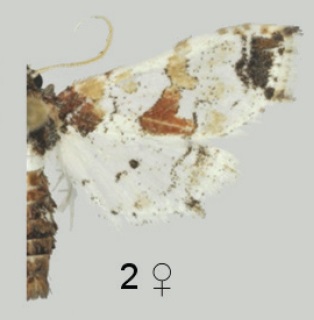
Leucinodes africensis is a species of moth in the family Crambidae. It is found in West Africa, Angola, the Democratic Republic of the Congo, Gabon and Tanzania. It has been intercepted with plant imports from Ghana and Zimbabwe to Great Britain and the Netherlands. The species was described by Richard Mally, Anastasia Korycinska, David J. L. Agassiz, Jayne Hall, Jennifer Hodgetts and Matthias Nuss in 2015.


















